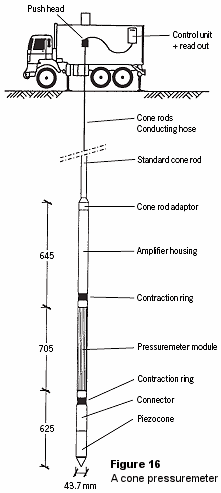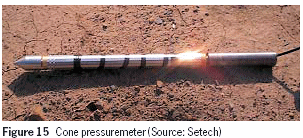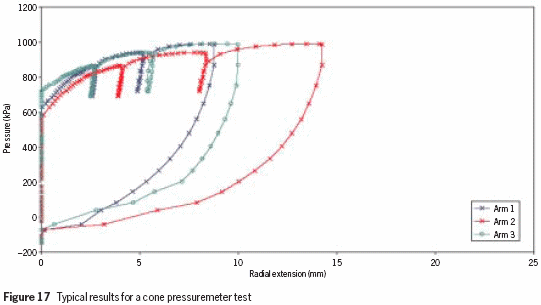Chapter 4
Part 1: Special cones: geotechnical cones
Cone pressuremeter
| CONE PRESSUREMETER 4.1 | |
 | The cone pressuremeter (Figure 15), also known as the full displacement pressuremeter, combines a conventional 60° cone penetration sounding with the pressuremeter test. The pressuremeter has the same diameter as a 15 cm2 cone (46 mm) and is mounted on the penetrometer shaft, a short distance behind the cone. The expanding part of the pressuremeter module has a length to diameter ratio of 10 to 1 to ensure a predominantly radial expansion of the pressuremeter membrane during inflation. Figure 16 shows the different parts of the cone pressuremeter.  |
| Parameters The cone pressuremeter is a device well suited to measuring both the soil strength and stiffness parameters. It allows the rapid and reliable measurement of the undrained shear strength in clays and relative density in sands, and the shear modulus in clays and sands. The test A cone pressuremeter test is carried out by allowing a pause in the cone penetration test and then inflating the instrument membrane with compressed gas using controlled stress and strain rates. During the test, unload–reload loops are performed to allow an assessment of the soil shear modulus to be determined. Figure 17 gives typical tests results. From the pressure strain curves, the undrained shear strength, the soil shear modulus and the in-situ horizontal stress can be obtained. For more about interpretation, see the book Cone penetration testing in geotechnical practice[2]. On completion of a test, the cone is advanced to the next test depth. In addition the pressuremeter membrane can be inflated to a large radial strain, approximately 50%, to ensure that the pressuremeter limit pressure is approached at full inflation. The speed of cone penetration testing enables the cone pressuremeter to be an economical alternative to conventional self-boring and Menard-type pressuremeter tests. |

